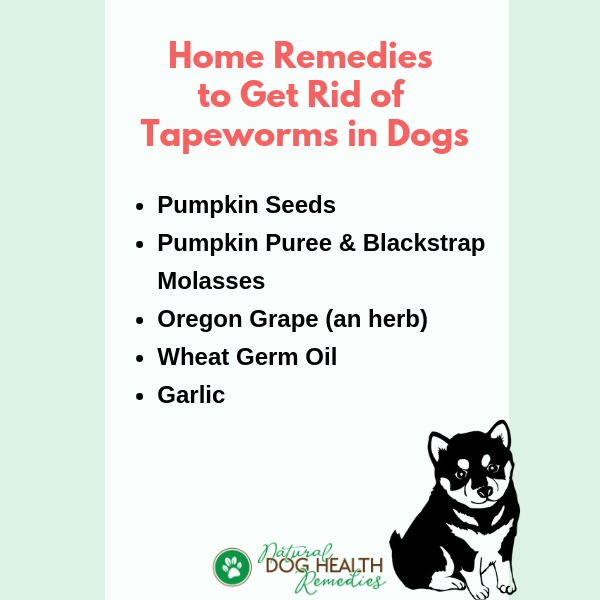Get Rid of Tapeworms in Dogs Using Natural Remedies

Tapeworm Lifecycle
Tapeworms are segmented flat worms. A tapeworm has a head and neck, followed by a number of segments.
They use the suckers on their heads to attach themselves to a dog's intestine. They do not have digestive systems of their own. Instead, they absorb nutrients through their skin.
Tapeworms belong to a class of organisms known as Cestoda. This class of organism use intermediate hosts in their transmission cycle.
Intermediate hosts can be fleas, fish, rodents, and domestic animals such as sheep and pigs.
Each tapeworm segment is able to reproduce. New segments are formed in the worm's neck region while mature segments, which contain large numbers of eggs, are at the end region.
Tapeworm segments containing eggs are shed in a dog's poop. When these eggs are ingested by an intermediate host, they hatch and the larvae migrate into the body tissue and develop. Yet they will not develop to full maturity in the body of the intermediate host.
When the intermediate host is ingested by a dog (the "definitive host"), the larvae proceed to develop into adult tapeworms.
How Can My Dog Get Infected?
By far the most common type of tapeworms in dogs is the "flea tapeworm" (Dipylidium caninum), also known as "double-pored tapeworm". It is so common because it uses the flea as an intermediate host.
Segments from the tapeworm are passed in the feces. The segments then dry out and release the eggs into the environment.
Flea larvae ingest these eggs, and tapeworm larvae begin development in their intermediate host. If the flea happens to be ingested by a dog while self-grooming, the tapeworm larvae will continue to develop into adult worms within the dog's small intestine.
Dogs can also get infected with other types of tapeworms, although not as frequently as the flea tapeworm. For example, dogs who eat raw meat may sometimes get infected with Echinococcus granulosus, another type of tapeworm.
Symptoms of Tapeworms in Dogs
Dogs with light infestation of tapeworms show little or no signs at all.
If a dog has a heavy infestation, he will gradually become malnourished because the tapeworms absorb most of the nutrients from the dog's intestinal wall. The dog may also show the following signs:
If your dog has tapeworms, you can sometimes see some white segments in your dog's poop. Sometimes, you can even find the segments hanging near the anus of the dog.
These segments may move (gross!) if recently passed. They cause itching to the dog - hence the scooting! If the segments have been passed for a while and have dried out, they look like grains of uncooked rice. (OK. No rice for dinner tonight!)
How to Get Rid of Tapeworms in Dogs Naturally
 Although the appearance of tapeworms is revolting, they won't kill a dog and are seldom a big threat to the dog's health. If a dog is healthy and has a strong immune system, tapeworm infestation is usually short-term and harmless.
Although the appearance of tapeworms is revolting, they won't kill a dog and are seldom a big threat to the dog's health. If a dog is healthy and has a strong immune system, tapeworm infestation is usually short-term and harmless.
Since deworming involves the use of rather strong chemicals which may put additional stress on our dog's body, holistic vets do not suggest using such a program to get rid of tapeworms.
If your dog has tapeworms, try the following milder herbal and other natural home remedies first. They are more gentle on your dog.
Pumpkin and Pumpkin Seeds
Freshly-ground pumpkin seeds can be fed to your dog to treat tapeworm infestation. Use whole raw seeds and grind them immediately before feeding the fine meal to your dog.
Depending on the size of your dog, you can give 1/4 to one teaspoon of ground pumpkin seeds to your dog for each meal.
Some dog parents also suggest pumpkin puree and blackstrap molasses. Mix 1 cup of 100% unsweetened pumpkin puree with 2 tablespoons of blackstrap molasses. Depending on the dog's size, give 2-4 tablespoons of the mixture to the dog every day for 4-5 days.
Oregon Grape
Oregon grape is an herb (nothing to do with grapes, which are of course toxic to dogs).
A tincture of Oregon grape can be fed to your dog to treat intestinal worms. (6 drops/10 pounds of body weight, twice a day for a week. Discontinue use for 2-3 days before resuming the twice daily dosage).
Wheat Germ Oil
Depending on the size of your dog, add up to 1 teaspoon of the oil to each meal to discourage tapeworms.
Garlic
Intestinal parasites such as tapeworms do not seem to like the sulfur compounds or volatile oils contained in garlic. (Be sure to read my article on garlic for dogs if you think this herb is toxic and shouldn't be given to dogs.)
Feeding fresh or powdered garlic or garlic in extract forms to your dog can help to expel tapeworms from the dog's body.
You may see an increase in visible tapeworm segments in your dog's stool after 2 to 3 weeks of daily garlic ingestion.
After 2 months or so, the tapeworms may disappear totally or at least will be down to acceptable levels.
An Herbal Formula for Tapeworms in Dogs
This natural herbal remedy contains the herb Quassia wood - an herb commonly used for treating worm infestations. In addition, the formula contains herbs such as pumpkin seed, slippery elm bark, fennel seed, and more, all of which are good for supporting and protecting the gastrointestinal tract.

Stay Away from Wormwood
You may have read about using the herb wormwood to deworm puppies and dogs.
True, wormwood has traditionall be used as a dewormer, but it has been found to be far too strong for pets.
Wormwood contains strong components that, if used excessively, can cause damage to the liver, kidneys, and even the nervous system.
The dilemma with wormwood is, if used in small amounts, it is ineffective in deworming. To be effective, we need to use higher doses, increasing the chances of harming our dogs' health!

Don't Forget After Care!
Dogs with worms, even the seemingly harmless tapeworms, usually have compromised immune and digestive systems.
Be sure to read the section on "After Care" on this article on dog worms in general. You will find information on how to use a healthy diet with supplements to help digestion and strengthen the dog's immunity.
Prevention of Tapeworms in Dogs
Flea control is the best way to prevent infestation of flea tapeworms in dogs.
Other tapeworms, such as Echinococcus, can be prevented by denying your dog access to raw meat and garbage.
Controlling Fleas Naturally

Eldredge, et al. Dog Owner's Home Veterinary Handbook 4th edition (Wiley Publishing, 2007).
C.J. Puotinen, Natural Remedies for Dogs and Cats (Keats Publishing, 1999).
M.L. Wulff-Tilford and G.L. Tilford, Herbs for Pets (Bowtie Press, 1999).
R.H. Pitcairn, The Complete Guide to Natural Health for Dogs and Cats (Rodale, 2005).





